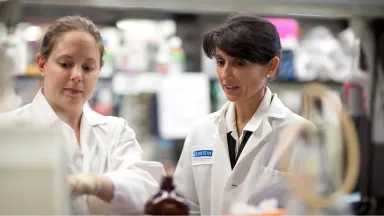
David Shechter, Ph.D.
- Professor, Department of Biochemistry
Area of research
- Fundamental mechanisms of gene and cellular regulation in cancer, ALS, and aging.
Phone
Location
- Albert Einstein College of Medicine Jack and Pearl Resnick Campus 1300 Morris Park Avenue Forchheimer Building 304 Bronx, NY 10461
Research Profiles
Professional Interests
Decoding how protein modifications regulate chromatin and RNA to control gene expression in cancer, aging, and neurodegeneration.
The Shechter Lab investigates how chemical modifications of proteins regulate gene expression by coordinating chromatin dynamics, RNA transcription, and RNA processing. We are driven by a deep curiosity for fundamental molecular mechanisms and aim to uncover principles that link gene regulation to disease contexts—including cancer, aging, and neurodegeneration.
Our work focuses on post-translational modifications (PTMs)—particularly arginine methylation and glutamylation—that alter the behavior of intrinsically disordered regions (IDRs) in RNA-binding proteins (RBPs) and chromatin regulators. These PTMs modulate protein-protein and protein-RNA interactions, influencing transcription, RNA metabolism, and biomolecular condensate formation.
We have long studied PRMT1 and PRMT5, which catalyze arginine methylation to regulate RBP function and RNA processing events such as splicing and nuclear export. In amyotrophic lateral sclerosis (ALS), we are investigating how arginine methylation governs stress granules, phase-separated condensates, and nucleocytoplasmic transport—and how PRMTs may be targeted for therapeutic intervention.
In parallel, we are defining nuclear roles for glutamate-glutamylation, mediated by TTLL4, which modifies acidic chromatin-associated proteins like histone chaperones. This pathway is emerging as a key player in acute myeloid leukemia (AML), particularly in cells expressing NPM1c mutations, where altered chromatin architecture drives oncogenic transcriptional programs.
We are also examining Glycine N-methyltransferase (GNMT), a small-molecule methyltransferase that connects one-carbon metabolism to gene regulation, with implications for aging and metabolic control of epigenetic pathways.
Using biochemistry, structural biology, functional genomics, and cellular models, we aim to define how these regulatory systems operate at molecular and systems levels—and how their dysregulation creates vulnerabilities that may be leveraged for therapeutic discovery.
Selected Publications
- Joseph D. DeAngelo, Maxim I. Maron, Jacob S. Roth, Subray Hegde, Aliza M. Silverstein, Varun Gupta, Stephanie Stransky, Joel Basken, Joey Azofeifa, Charles C. Query, Simone Sidoli, Matthew J. Gamble, David Shechter. Productive mRNA Chromatin Escape is Promoted by PRMT5 Activity. Mol Cell, 2025.
- Jacob S. Roth, Joseph D. DeAngelo, Dejauwne L. Young, Maxim I. Maron, Ankita Saha, Hugo Pinto, Varun Gupta, Noah Jacobs, Subray Hegde, Jennifer T. Aguilan, Joel Basken, Joey Azofeifa, Charles C. Query, Simone Sidoli, Arthur I. Skoultchi, David Shechter, PRMT5 activity sustains histone production to maintain genome integrity bioRxiv 2025
- Alexandra Schurer, Humaira Ilyas, Maxim I. Maron, Subray Hegde, Melissa R. Leyden, Irene Roy, Rotila Hyka, Lucas Dada, Jeffrey Shabanowitz, Donald F. Hunt, Ellen Angeles, Victor Morell, Benjamin M. Lorton, Shira Glushakow-Smith, Daniel K. Borger, Yuxuan Wang, Linde Miles, Roger Belizaire, Seiya Kitamura, Kira Gritsman, and David Shechter, 2025. TTLL4 glutamyltransferase is a therapeutic target for NPM1-mutated acute myeloid leukemia, bioRxiv, 2025.04.07.647605;
- Benjamin M. Lorton, Christopher Warren, Humaira Ilyas, Prithviraj Nandigrami, Subray Hegde, Sean Cahill, Stephanie M Lehman, Jeffrey Shabanowitz, Donald F. Hunt, Andras Fiser, David Cowburn, David Shechter. Glutamylation of Npm2 and Nap1 acidic disordered regions increases DNA mimicry and histone chaperone efficiency. iScience 2024
- Maxim I Maron, Alyssa D Casill, Varun Gupta, Jacob S Roth, Simone Sidoli, Charles C Query, Matthew J Gamble, David Shechter. Type I and II PRMTs inversely regulate post-transcriptional intron detention through Sm and CHTOP methylation. eLife, 2022
- Maxim I. Maron, Stephanie M. Lehman, Sitaram Gayatri, Joseph D. DeAngelo, Subray Hegde, Benjamin M. Lorton, Yan Sun, Dina L. Bai, Simone Sidoli, Varun Gupta, Matthew R. Marunde, James R. Bone, Zu-Wen Sun, Mark T. Bedford, Jeffrey Shabanowitz, Hongshan Chen, Donald F. Hunt, David Shechter, Independent transcriptomic and proteomic regulation by type I and II protein arginine methyltransferases, iScience, Volume 24, Issue 9, 2021
- Benjamin M. Lorton, Rajesh K. Harijan, Emmanuel S. Burgos, Jeffrey B. Bonanno, Steven C. Almo, and David Shechter. A binary arginine methylation switch on histone H3 Arginine 2 regulates its interaction with WDR5. Biochemistry, Jun 2020.
- Christopher Warren, Tsutomu Matsui, Jerome Karp, Takashi Onikubo, Sean Cahil, Michael Brenowitz, David Cowburn, Mark Girvin, and David Shechter. Dynamic intramolecular regulation of the histone chaperone nucleoplasmin controls histone binding and release. Nature Communications, 2017
- Emmanuel S. Burgos, Ryan O. Walters, Derek M. Huffman and David Shechter. A simplified characterization of S-adenosyl-L-methionine-consuming enzymes with 1-Step EZ-MTase: a universal and straightforward coupled-assay for in vitro and in vivo setting. Chem. Sci., 2017
- The PRMT5 arginine methyltransferase: many roles in development, cancer, and beyond. Nicole Stopa, Jocelyn Krebs, David Shechter. Cellular and Molecular Life Sciences, 2015.





